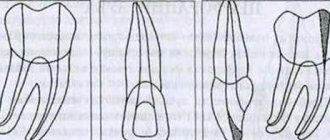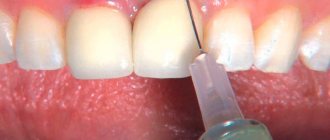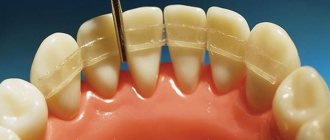Features of endodontic treatment
Since childhood, for many, going to the dentist is inevitably associated with pain. Basically, this is just a psychological factor caused by the visual perception of the dental office almost like a hospital operating room. Most dental procedures are painless thanks to a combination of advanced treatment techniques and the use of effective local anesthesia. If we talk about endodontic dental treatment, it is somewhat painful, but this, firstly, is logically explainable, and secondly, the pain will be present for a short period. When a focus of infection appears in our body, pain is a natural reaction and a signal to action. This is inherent in nature itself. In the case of endodontics, we are talking about inflamed nervous tissue, which, of course, creates unpleasant sensations. However, an experienced dentist, using high-quality anesthetics, is able to carry out all the necessary actions with minimal discomfort for you. For some time after the end of treatment, increased sensitivity of the tooth to external influences cannot be ruled out. This feature does not appear for long and is easily eliminated with available medications.
What awaits the patient after endodontic therapy?
After treatment is completed, the dentist’s further actions depend on the condition of the tooth. If the condition of the tooth allows, the doctor restores the anatomical shape of the dental unit using composite materials. Modern composites make it possible to do this aesthetically and as durable as possible. If it is necessary to strengthen the crown part, a pin can be installed in the tooth. If a dental element has significant defects, then dentists, after depulping and filling the canals, recommend orthopedic treatment, i.e., installation of an artificial crown. This measure is necessary to ensure the integrity of the dental element.
The dental network offers services for the treatment of dental diseases of any severity. Contacting our branches has obvious advantages:
- treatment by highly qualified dentists;
- compliance with treatment protocols and procedures that meet international standards;
- providing family and cumulative discounts;
- Convenient daily work schedule.
You can contact any of the branches of our clinic in Moscow, located within walking distance from metro stations:
- Alekseevskaya (VDNKh district, etc. Mira), address: st. 3rd Mytishchiskaya house 3, building 2;
- Shelepikha, address: Shelepikhinskaya embankment, building 34, building 1.
Mastery of modern technologies helps our doctors effectively perform endodontic treatment. The high qualifications of our specialists serve as a guarantee of quality and safety. The health of your teeth is in good hands!
How do human teeth work?
The structure of the human tooth cannot be called complex. The visible part of the tooth (crown) is located above the gum, and inside the gum are the roots of the tooth. They serve as attachments to the jaw bones. As we said at the beginning of the article, inside the tooth there is a canal (root) containing blood vessels, as well as nervous tissue - together they are called the pulp. Thanks to nerve endings, teeth are able to signal us about the occurrence of infections or aggressive influence of external factors. The outside of the tooth is covered with a protective layer – enamel. The hard tissue of the tooth itself is called dentin. Dentin and enamel are mainly composed of mineral substances (96 and 70 percent, respectively).
Prerequisites for the disease, methods of endodontic treatment
Most often, the root cause of infection is sudden or sequential damage to the hard tissue of the tooth, as a result of which bacteria penetrate into the root cavity and inflammation of the pulp occurs. This is characterized by the occurrence of acute pain, which intensifies upon contact with cold or hot food, as well as simple touches to the tooth.
Root canal treatment in such cases is not only recommended, but also necessary, since without it, the infection begins to spread rapidly, affecting adjacent healthy teeth, as well as soft tissues. The tooth itself begins to decay. Let's consider possible dental treatment options:
— removal of the tooth (or what’s left of it) is inevitable in advanced cases, however, by starting treatment at an early stage it is possible to save it. It is worth noting that removal, although it is an effective solution, has its side effects - in particular, it can provoke deformation of the position of adjacent teeth and disruption of a healthy bite;
— tooth extraction followed by implant installation. This method reduces the negative consequences of conventional removal, however, in any situation where there is a possibility of saving a tooth, it should be used, since even the most expensive implant is not capable of becoming a 100% functional replacement of a real tooth. In addition, implant placement is an expensive procedure; in most cases, endodontic treatment, started in a timely manner, turns out to be not only preferable, but also cost-effective;
- endodontic therapy - we outlined its principle at the beginning of the article. This type of therapy is characterized by the highest degree of effectiveness, allowing you to quickly get rid of the infectious inflammatory process and maintain dental health. Depending on the degree of tooth damage and the advanced stage of the disease, treatment may take several visits (no more than three). The first step is to provide access to the root canal and clean it, followed by disinfection and filling with solution. However, if the infection is widespread, as well as the presence of several canals, repeat visits to the dentist will be required. The final step will be to install the seal. This stage is very important, since a tooth deprived of pulp (and with it a significant part of its nutrition) becomes weak, and installing a filling (and in some cases, a crown) allows it to be strengthened.
Root canal treatment (Endodontics)
Has your dentist told you that you need endodontic or root canal treatment? If so, then you are not alone. In modern dentistry this is one of the most common procedures. Millions of teeth are saved each year through endodontic treatment - root canal treatment. The success of endodontic treatment is directly related to the use of a microscope. Multiple magnification allows you to see each canal and its branches, and see cracks in the walls or root of the tooth. Dental treatment under a microscope in Moscow allows you to accurately determine the number and parameters of the canals, as well as fully fill them.
This page explains in detail the root canal procedure and how it can relieve your tooth pain and save your smile.
"Endo" comes from the Greek word for "inside" and "odont" comes from the Greek word for "tooth." Endodontically treats the inside of the tooth. Root canal treatment is a type of endodontic treatment. To better understand endodontic treatment, it is necessary to understand basic dental anatomy. Inside the tooth, underneath the white enamel and hard layer called dentin, is soft tissue called pulp. This soft tissue contains blood vessels, nerve endings and connective tissue, and is the basis for the growth of the surrounding hard tissues of the tooth during its development.
The pulp extends from the crown of the tooth to the tip of the roots, where it connects with the bone tissue surrounding the root. Soft tissue (pulp) is important during tooth growth and development. However, once a tooth is fully formed, it can continue to function without pulp because the tooth can receive nutrition from the tissues surrounding it.
Why is an endodontic procedure necessary?
Endodontic treatment is necessary when the pulp, the soft tissue inside the root canal, is inflamed or infected. Inflammation or infection can have many causes: deep caries, a crack or chip in the tooth. In addition, trauma to the tooth can cause damage to the pulp, even if the tooth has no visible chips or cracks. If pulp inflammation or infection is left untreated, it will cause toothache and can lead to more serious problems such as an abscess.
What are the signs that you need endodontic treatment?
Symptoms include pain, prolonged sensitivity to heat or cold, sensitivity to touching and chewing food, tooth discoloration, swelling, and tenderness in the lymph nodes and nearby bone and gum tissue. In rare cases, there may be no symptoms and diagnosis of endodontic disease is possible only through radiographic examination.
How can endodontic treatment save a tooth?
The endodontist removes the inflamed or infected pulp, thoroughly cleans and shapes the inside of the root canal, then fills and seals the space. After this, the dentist will install an artificial crown or, if possible, install a permanent filling and restore the tooth to protect it and restore it to full functionality. Once restored, the tooth continues to function like any other tooth.
Will I feel pain during or after the procedure?
Most endodontic procedures are performed to relieve pain caused by pulp inflammation or infection. With modern treatment methods and anesthetics, the vast majority of patients do not feel pain and feel comfortable during the procedure.
Your tooth may be sensitive in the first few days after treatment, especially if there was pain or infection before the procedure. This discomfort can be eliminated with the help of various medications. Follow your doctor's instructions carefully. If you have severe pain or pain that lasts more than a few days, be sure to see your doctor for further testing.
Step-by-step endodontic procedure.
Endodontic treatment can often be performed in one or two visits and involves the following steps:
- The endodontist examines and takes x-rays of the tooth, then injects a local anesthetic. After anesthesia has caused loss of sensation, the dentist places a small protective sheet - a dental dam - over the area to isolate the tooth and keep it clean and free of saliva during the procedure.
- The endodontist uses a bur to open access to the root canals - making a hole in the crown of the tooth. The hole is made, as a rule, in a place affected by caries. After opening access to the root canals, the Endodontist cleans the canals using special instruments - reamers, which in appearance resemble needles with a rough surface. Cleaning of the canals is carried out in several stages using reamers of various diameters until the canals are completely free of soft tissue. For the most effective cleaning of channels, it is necessary to determine their length. If the canal is not completely cleaned along its entire length, this can lead to re-inflammation of the remaining pulp. Various methods are used to monitor the quality of root canal cleaning - from x-rays to modern devices, for example, such as an apex locator, the electrical signals of which allow you to accurately determine the depth of the canal. The most modern method of endodontics at the moment is the treatment of canals under a dental microscope.
- After mechanical cleaning of the canals is carried out, microparticles and bacteria are still present in the canal. To completely disinfect the canal before filling, so-called chemical cleaning is carried out with a special solution that kills bacteria, microorganisms and dissolves pulp residues.
- Once the space is cleaned and shaped, the Endodontist fills the root canals with a biocompatible material called gutta-percha, which is similar in properties to rubber. Gutta-percha is placed into the root canal with cement adhesive to achieve a complete seal. As a rule, after filling the canals with gutta-percha, the dentist installs a temporary filling to close the hole in the dentin and protect the root canals. The temporary filling will be removed by your dentist before the tooth is restored.
- After endodontic treatment, you should return to your dentist to complete the restoration of the tooth. This can be an artificial crown, a ceramic inlay or a permanent filling, if the structure and degree of tooth decay allows this.
Is any special care or treatment required for the tooth after endodontic treatment?
You should not chew or bite the treated tooth until you have restored it to full working order. An unrestored tooth may be fragile, so you should see your dentist as soon as possible for a complete tooth restoration.
In the vast majority of cases, teeth that have undergone endodontic procedures will last as long as your natural teeth.
Will endodontic treatment always help?
Most teeth can be saved with root canal treatment in emergency dentistry. However, sometimes a tooth cannot be saved because root canals are inaccessible, the root is severely damaged, or the tooth cannot be restored. However, advances in endodontics are making it possible to save teeth that would have been lost even a few years ago. When endodontic treatment is ineffective, endodontic surgery can save the tooth.
Complications and prevention of pulp diseases
In the hands of an experienced dental surgeon, there is reason to rest in peace and confidence in a favorable outcome of treatment. After all, problems often arise due to insufficient qualifications of the doctor, ranging from incorrect diagnosis, as a result of which the problem is not fully identified and the infection continues to remain in one of the canals, ending with unprofessional installation of filling materials, due to which the infection can re-enter the canal. Unexpected damage to tooth tissue may also occur during treatment. To avoid complications (mainly in complex cases), antibiotics are prescribed in parallel with treatment.
The best prevention (besides regular visits to the dentist - at least once every six months) is simple and accessible to everyone: brushing your teeth using a suitable toothbrush and recommended toothpastes; rejection of bad habits; reducing consumption of foods high in sugar - most of these recommendations are appropriate both for the prevention of dental disease and for simply following the principles of a healthy lifestyle.
What is pulpitis and how does it develop?
Pulpitis is an inflammation of the dental pulp (i.e., the neurovascular bundle located in the center of the tooth and in the root canals).
Most often, pulpitis is of an infectious nature, i.e. caused by microbes penetrating from the carious cavity. Therefore, if caries is not cured in time, then sooner or later it will “get” to the pulp of the tooth. Sometimes non-infectious pulpitis occurs, for example, in case of tooth trauma or after improper (too aggressive) treatment of the tooth with a bur.
If microorganisms penetrate the neurovascular bundle of the tooth, the process of inflammation and decay of the pulp is irreversible.
There are conservative methods for treating pulpitis. In this case, special medications that have an antiseptic and anti-inflammatory effect are applied to the “nerve” of the tooth. But these methods are effective only in a small percentage of cases, only when the inflammation process has just begun. In addition, the indications for the use of these techniques are very limited.
Most often, the only true and reliable method of treating pulpitis is to remove the entire pulp (“nerve”) from the tooth cavity and from the root canals, followed by filling them with filling material. This treatment method is called tooth depulpation . In general, any type of treatment of pulpitis or periodontitis associated with the treatment and filling of root canals is called endodontic treatment.










